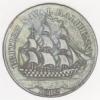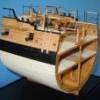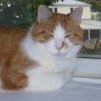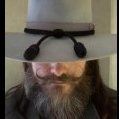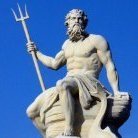-
Posts
470 -
Joined
-
Last visited
Reputation Activity
-

-
 Erik W got a reaction from Tossedman in HM Cutter Cheerful 1806 by Erik W - 1:48 scale
Erik W got a reaction from Tossedman in HM Cutter Cheerful 1806 by Erik W - 1:48 scale
I finished the woodwork on the mast. Everything is square and lines up as it should. The further I get into this project the more I am compulsively measuring, test fitting, etc. It really does prevent any nasty surprises down the road. I made the mast tree so that all the parts would fit with light press fitting, so the tolerances are tight enough to assemble it without the need for glue. This made it easier to test fit on the mast. I did use glue for the final assembly. The cheeks were a bit tricky. Being new to this ship building gig, I wasn't quite sure how all the shapes are accomplished. I have David Antscherl's book The Fully Framed Model - Rigging a Sixth Rate Sloop of 1767-1780 - Volume IV which has some clear photos of what material to take off the mast. Though I see a couple of areas in my photos below that need some touch up, overall I'm happy withe the way the mast turned out.
Erik
-
 Erik W got a reaction from egkb in HM Cutter Cheerful 1806 by Erik W - 1:48 scale
Erik W got a reaction from egkb in HM Cutter Cheerful 1806 by Erik W - 1:48 scale
I finished the woodwork on the mast. Everything is square and lines up as it should. The further I get into this project the more I am compulsively measuring, test fitting, etc. It really does prevent any nasty surprises down the road. I made the mast tree so that all the parts would fit with light press fitting, so the tolerances are tight enough to assemble it without the need for glue. This made it easier to test fit on the mast. I did use glue for the final assembly. The cheeks were a bit tricky. Being new to this ship building gig, I wasn't quite sure how all the shapes are accomplished. I have David Antscherl's book The Fully Framed Model - Rigging a Sixth Rate Sloop of 1767-1780 - Volume IV which has some clear photos of what material to take off the mast. Though I see a couple of areas in my photos below that need some touch up, overall I'm happy withe the way the mast turned out.
Erik
-
 Erik W got a reaction from Seventynet in HM Cutter Cheerful 1806 by Erik W - 1:48 scale
Erik W got a reaction from Seventynet in HM Cutter Cheerful 1806 by Erik W - 1:48 scale
I finished the woodwork on the mast. Everything is square and lines up as it should. The further I get into this project the more I am compulsively measuring, test fitting, etc. It really does prevent any nasty surprises down the road. I made the mast tree so that all the parts would fit with light press fitting, so the tolerances are tight enough to assemble it without the need for glue. This made it easier to test fit on the mast. I did use glue for the final assembly. The cheeks were a bit tricky. Being new to this ship building gig, I wasn't quite sure how all the shapes are accomplished. I have David Antscherl's book The Fully Framed Model - Rigging a Sixth Rate Sloop of 1767-1780 - Volume IV which has some clear photos of what material to take off the mast. Though I see a couple of areas in my photos below that need some touch up, overall I'm happy withe the way the mast turned out.
Erik
-

-
 Erik W reacted to Stuntflyer in HM Cutter Cheerful 1806 by Erik W - 1:48 scale
Erik W reacted to Stuntflyer in HM Cutter Cheerful 1806 by Erik W - 1:48 scale
So much fun. Well done, Erik!
-
 Erik W got a reaction from Mike Y in HM Cutter Cheerful 1806 by Erik W - 1:48 scale
Erik W got a reaction from Mike Y in HM Cutter Cheerful 1806 by Erik W - 1:48 scale
I finished the woodwork on the mast. Everything is square and lines up as it should. The further I get into this project the more I am compulsively measuring, test fitting, etc. It really does prevent any nasty surprises down the road. I made the mast tree so that all the parts would fit with light press fitting, so the tolerances are tight enough to assemble it without the need for glue. This made it easier to test fit on the mast. I did use glue for the final assembly. The cheeks were a bit tricky. Being new to this ship building gig, I wasn't quite sure how all the shapes are accomplished. I have David Antscherl's book The Fully Framed Model - Rigging a Sixth Rate Sloop of 1767-1780 - Volume IV which has some clear photos of what material to take off the mast. Though I see a couple of areas in my photos below that need some touch up, overall I'm happy withe the way the mast turned out.
Erik
-
 Erik W got a reaction from Danstream in HM Cutter Cheerful 1806 by Erik W - 1:48 scale
Erik W got a reaction from Danstream in HM Cutter Cheerful 1806 by Erik W - 1:48 scale
I finished the woodwork on the mast. Everything is square and lines up as it should. The further I get into this project the more I am compulsively measuring, test fitting, etc. It really does prevent any nasty surprises down the road. I made the mast tree so that all the parts would fit with light press fitting, so the tolerances are tight enough to assemble it without the need for glue. This made it easier to test fit on the mast. I did use glue for the final assembly. The cheeks were a bit tricky. Being new to this ship building gig, I wasn't quite sure how all the shapes are accomplished. I have David Antscherl's book The Fully Framed Model - Rigging a Sixth Rate Sloop of 1767-1780 - Volume IV which has some clear photos of what material to take off the mast. Though I see a couple of areas in my photos below that need some touch up, overall I'm happy withe the way the mast turned out.
Erik
-
 Erik W got a reaction from Cathead in HM Cutter Cheerful 1806 by Erik W - 1:48 scale
Erik W got a reaction from Cathead in HM Cutter Cheerful 1806 by Erik W - 1:48 scale
I finished the woodwork on the mast. Everything is square and lines up as it should. The further I get into this project the more I am compulsively measuring, test fitting, etc. It really does prevent any nasty surprises down the road. I made the mast tree so that all the parts would fit with light press fitting, so the tolerances are tight enough to assemble it without the need for glue. This made it easier to test fit on the mast. I did use glue for the final assembly. The cheeks were a bit tricky. Being new to this ship building gig, I wasn't quite sure how all the shapes are accomplished. I have David Antscherl's book The Fully Framed Model - Rigging a Sixth Rate Sloop of 1767-1780 - Volume IV which has some clear photos of what material to take off the mast. Though I see a couple of areas in my photos below that need some touch up, overall I'm happy withe the way the mast turned out.
Erik
-
 Erik W got a reaction from alde in HM Cutter Cheerful 1806 by Erik W - 1:48 scale
Erik W got a reaction from alde in HM Cutter Cheerful 1806 by Erik W - 1:48 scale
I finished the woodwork on the mast. Everything is square and lines up as it should. The further I get into this project the more I am compulsively measuring, test fitting, etc. It really does prevent any nasty surprises down the road. I made the mast tree so that all the parts would fit with light press fitting, so the tolerances are tight enough to assemble it without the need for glue. This made it easier to test fit on the mast. I did use glue for the final assembly. The cheeks were a bit tricky. Being new to this ship building gig, I wasn't quite sure how all the shapes are accomplished. I have David Antscherl's book The Fully Framed Model - Rigging a Sixth Rate Sloop of 1767-1780 - Volume IV which has some clear photos of what material to take off the mast. Though I see a couple of areas in my photos below that need some touch up, overall I'm happy withe the way the mast turned out.
Erik
-
 Erik W got a reaction from dvm27 in HM Cutter Cheerful 1806 by Erik W - 1:48 scale
Erik W got a reaction from dvm27 in HM Cutter Cheerful 1806 by Erik W - 1:48 scale
I finished the woodwork on the mast. Everything is square and lines up as it should. The further I get into this project the more I am compulsively measuring, test fitting, etc. It really does prevent any nasty surprises down the road. I made the mast tree so that all the parts would fit with light press fitting, so the tolerances are tight enough to assemble it without the need for glue. This made it easier to test fit on the mast. I did use glue for the final assembly. The cheeks were a bit tricky. Being new to this ship building gig, I wasn't quite sure how all the shapes are accomplished. I have David Antscherl's book The Fully Framed Model - Rigging a Sixth Rate Sloop of 1767-1780 - Volume IV which has some clear photos of what material to take off the mast. Though I see a couple of areas in my photos below that need some touch up, overall I'm happy withe the way the mast turned out.
Erik
-
 Erik W got a reaction from CiscoH in HM Cutter Cheerful 1806 by Erik W - 1:48 scale
Erik W got a reaction from CiscoH in HM Cutter Cheerful 1806 by Erik W - 1:48 scale
I finished the woodwork on the mast. Everything is square and lines up as it should. The further I get into this project the more I am compulsively measuring, test fitting, etc. It really does prevent any nasty surprises down the road. I made the mast tree so that all the parts would fit with light press fitting, so the tolerances are tight enough to assemble it without the need for glue. This made it easier to test fit on the mast. I did use glue for the final assembly. The cheeks were a bit tricky. Being new to this ship building gig, I wasn't quite sure how all the shapes are accomplished. I have David Antscherl's book The Fully Framed Model - Rigging a Sixth Rate Sloop of 1767-1780 - Volume IV which has some clear photos of what material to take off the mast. Though I see a couple of areas in my photos below that need some touch up, overall I'm happy withe the way the mast turned out.
Erik
-
 Erik W got a reaction from Thukydides in HM Cutter Cheerful 1806 by Erik W - 1:48 scale
Erik W got a reaction from Thukydides in HM Cutter Cheerful 1806 by Erik W - 1:48 scale
I finished the woodwork on the mast. Everything is square and lines up as it should. The further I get into this project the more I am compulsively measuring, test fitting, etc. It really does prevent any nasty surprises down the road. I made the mast tree so that all the parts would fit with light press fitting, so the tolerances are tight enough to assemble it without the need for glue. This made it easier to test fit on the mast. I did use glue for the final assembly. The cheeks were a bit tricky. Being new to this ship building gig, I wasn't quite sure how all the shapes are accomplished. I have David Antscherl's book The Fully Framed Model - Rigging a Sixth Rate Sloop of 1767-1780 - Volume IV which has some clear photos of what material to take off the mast. Though I see a couple of areas in my photos below that need some touch up, overall I'm happy withe the way the mast turned out.
Erik
-
 Erik W got a reaction from baribeaujm in HM Cutter Cheerful 1806 by Erik W - 1:48 scale
Erik W got a reaction from baribeaujm in HM Cutter Cheerful 1806 by Erik W - 1:48 scale
I finished the woodwork on the mast. Everything is square and lines up as it should. The further I get into this project the more I am compulsively measuring, test fitting, etc. It really does prevent any nasty surprises down the road. I made the mast tree so that all the parts would fit with light press fitting, so the tolerances are tight enough to assemble it without the need for glue. This made it easier to test fit on the mast. I did use glue for the final assembly. The cheeks were a bit tricky. Being new to this ship building gig, I wasn't quite sure how all the shapes are accomplished. I have David Antscherl's book The Fully Framed Model - Rigging a Sixth Rate Sloop of 1767-1780 - Volume IV which has some clear photos of what material to take off the mast. Though I see a couple of areas in my photos below that need some touch up, overall I'm happy withe the way the mast turned out.
Erik
-
 Erik W got a reaction from JpR62 in HM Cutter Cheerful 1806 by Erik W - 1:48 scale
Erik W got a reaction from JpR62 in HM Cutter Cheerful 1806 by Erik W - 1:48 scale
I finished the woodwork on the mast. Everything is square and lines up as it should. The further I get into this project the more I am compulsively measuring, test fitting, etc. It really does prevent any nasty surprises down the road. I made the mast tree so that all the parts would fit with light press fitting, so the tolerances are tight enough to assemble it without the need for glue. This made it easier to test fit on the mast. I did use glue for the final assembly. The cheeks were a bit tricky. Being new to this ship building gig, I wasn't quite sure how all the shapes are accomplished. I have David Antscherl's book The Fully Framed Model - Rigging a Sixth Rate Sloop of 1767-1780 - Volume IV which has some clear photos of what material to take off the mast. Though I see a couple of areas in my photos below that need some touch up, overall I'm happy withe the way the mast turned out.
Erik
-
 Erik W got a reaction from rcweir in HM Cutter Cheerful 1806 by Erik W - 1:48 scale
Erik W got a reaction from rcweir in HM Cutter Cheerful 1806 by Erik W - 1:48 scale
I finished the woodwork on the mast. Everything is square and lines up as it should. The further I get into this project the more I am compulsively measuring, test fitting, etc. It really does prevent any nasty surprises down the road. I made the mast tree so that all the parts would fit with light press fitting, so the tolerances are tight enough to assemble it without the need for glue. This made it easier to test fit on the mast. I did use glue for the final assembly. The cheeks were a bit tricky. Being new to this ship building gig, I wasn't quite sure how all the shapes are accomplished. I have David Antscherl's book The Fully Framed Model - Rigging a Sixth Rate Sloop of 1767-1780 - Volume IV which has some clear photos of what material to take off the mast. Though I see a couple of areas in my photos below that need some touch up, overall I'm happy withe the way the mast turned out.
Erik
-
 Erik W got a reaction from Freebird in HM Cutter Cheerful 1806 by Erik W - 1:48 scale
Erik W got a reaction from Freebird in HM Cutter Cheerful 1806 by Erik W - 1:48 scale
I finished the woodwork on the mast. Everything is square and lines up as it should. The further I get into this project the more I am compulsively measuring, test fitting, etc. It really does prevent any nasty surprises down the road. I made the mast tree so that all the parts would fit with light press fitting, so the tolerances are tight enough to assemble it without the need for glue. This made it easier to test fit on the mast. I did use glue for the final assembly. The cheeks were a bit tricky. Being new to this ship building gig, I wasn't quite sure how all the shapes are accomplished. I have David Antscherl's book The Fully Framed Model - Rigging a Sixth Rate Sloop of 1767-1780 - Volume IV which has some clear photos of what material to take off the mast. Though I see a couple of areas in my photos below that need some touch up, overall I'm happy withe the way the mast turned out.
Erik
-
 Erik W reacted to Mike Y in Beavers Prize 1777 by Mike Y - 1:48 - POF - Hahn style
Erik W reacted to Mike Y in Beavers Prize 1777 by Mike Y - 1:48 - POF - Hahn style
Time for some side projects
Fist I was concerned about the side-to-side alignment inside the hull.
The height measurement gauge is asymmetrical, and flipping it around may introduce some measurement errors. So I wanted to make a pointy thing that can be moved side-by-side on the top gantry.
There was a question in another log - "what is the mill for" - here is a classic example of a simple part that should be square with a precise and square-profiled recess. Mill is much more consistent and requires less skill than a "well tuned table saw", for example.
For the "pointy bit" I needed something very soft to avoid scratching the part. Basswood from the Model Shipways kit was ideal - I use it a lot as a soft lining for clamps and jigs.
I wanted to practice milling it in a rotary table instead of using lathe or a rotary tool. Not the best idea, the finish was not smooth at all (though such a soft wood is not making the task easier)
The resulting gadget. When in action - only one clamp is holding the arm in the correct position, while the assembly slides side to side. Should work even with curved beams, by probing the ends of the beam.
In action:
-
 Erik W reacted to Mike Y in Beavers Prize 1777 by Mike Y - 1:48 - POF - Hahn style
Erik W reacted to Mike Y in Beavers Prize 1777 by Mike Y - 1:48 - POF - Hahn style
Next up was the problem of wood stock preparation.
Majority of the interior construction is made out of relatively small lumber, 2-4mm in 1:48 scale. I could never cut those perfectly on a table saw, they always need a lot of finessing later on, resulting in an uneven strip. The wood sheets I have are 1 or 2 or 3mm thick, so more sanding is needed if you need something in between. The strip preparation was taking too much efforts.
A thickness sander would be ideal, but the only one in a small scale is Byrnes, which is rather a collector item nowadays.
DYI options are not appealing either, and they are still noisy and dusty.
Another alternative is a thickness planing jig. Most of them are too complicated for my task - with knobs and adjustments leading to inaccuracies, so I decided to use spacers. The range of required thicknesses is rather narrow - on of the largest parts (gun deck beam) is just around 4mm thick.
Decided to build the jig out of scrap piece of walnut. Did not want to risk using plywood, the grooves might end up on a wrong layer, resulting in an uneven surface. They are tiny, but need to be smooth.
Cutting precise grooves on a table saw is not so easy, but slow and steady does the job
Router plane helps to clean up the bottom of the groove:
Resulting jig, custom made for the miniature Veritas bench plane:
Spacers are made out of styrene, very good material for that. Easy to get in a variety of thicknesses, affordable, does not warp with moisture, fairly hard (to avoid compressing too much when planing). I have cut a bunch of spacers with a smallest increment of 0.25mm, should be enough for the range of thicknesses I need.
Jig in action:
Quite happy with it! Simple jig, but very effective. And perfectly quiet
The finish is incredibly smooth out of the box, so I can use the part right away with no further surface cleanup or sanding. If necessary - should not be hard to add a sanding block for the same jig.
I could easily get down to 1mm thickness, anything lower - and it is better to hold the "tail" of the strip rather than push it into the stop, otherwise it might get wavy.
-
 Erik W reacted to marsalv in L'Amarante by marsalv - 1:36 - POF
Erik W reacted to marsalv in L'Amarante by marsalv - 1:36 - POF
I adjusted the controls on my ropewalk and started winding the ropes. I started with the weaker ones, which are easier to wind, but there are a few more of them. The first batch is done.
-
 Erik W got a reaction from egkb in HM Cutter Cheerful 1806 by Erik W - 1:48 scale
Erik W got a reaction from egkb in HM Cutter Cheerful 1806 by Erik W - 1:48 scale
Thanks for the likes folks, and kind words Mike. I finished shaping the mast over the last week. I had planned on turning it using my power drill after sanding it to 8 sides. I couldn't get it to not wobble when chucked in though. I wound up just using the same "shoe-shine' hand sanding method that I did with the bowsprit. This was time consuming, but admittedly I like the control with removing material by hand. It's easier to not accidentally remove too much. After making the bowsprit, and now the mast, I'm getting the hang of how to do this by hand. So I'll use the same methods for the remaining spars. I filed the square tennon at the top of the mast, and lastly cut the sheeve in. Surprisingly, the mast fit into the mast coat with barely any additional sanding. It sits at the correct angle when compared to the plans. Also, once I get to the point of attaching the mast and spars permanently, I have no idea how, or where, I'm going to be able to photograph the build in it's entirety!
Erik
-
 Erik W got a reaction from Tossedman in HM Cutter Cheerful 1806 by Erik W - 1:48 scale
Erik W got a reaction from Tossedman in HM Cutter Cheerful 1806 by Erik W - 1:48 scale
Thanks for the likes, and thanks for the kind word Mike and Al. I have finished the bowsprit. The aft end is painted black and I used a pencil to darken the sheeve at the fore end. Following Chuck's instructions, I used black construction paper to simulate the metal band on the end of the bowsprit. I had made the four eye bolts very small in diameter, but then read other build logs where folks were having problems attaching the seizings and hooks, particularly on the two side eye bolts. So I redid all to a little bigger diameter that would handle the .018" rope and 24 gauge hooks in the loop of the eye bolts. I've decided to make the rest of the spars before I permanently attach the bowsprit step, and attach and rig the bowsprit, so the eye bolts are not yet glued into the bowsprit end as it will have to be inserted in the bulwarks hole first. It took quite a while of careful filing to get the hole in the bulwarks to the correct diameter with no gaps between it and the bowsprit. I wound up purchasing a round file used to sharpen chainsaws for the task. The round needle files I have on hand are too small in diameter to work well. Once I was able to fit the bowsprit the way I wanted it, I then practiced fitting it with the bow cannons in place, and figured out how I would do the final mounting. Once satisfied that I could glue the bowsprit and bowsprit step in place while the cannons were there, I went ahead and permanently attached the cannons. I've spent the last couple of days preparing the mast for shaping. It's hard to see on the photo below, but the 7/10/7 lines are drawn on the part that will be rounded, and the limit lines for the top part that will be square are there as well. I also left some extra material at the top of the mast so I can chuck it in my power drill when the time comes to turn it. I hand drilled the holes for the sheeve. After measuring VERY carefully with my digital calipers, I stared with a .016" bit, drilling halfway through the 3/8" square mast stock. I then did the same thing from the other side. I was almost surprised that the holes actually lined up! I then widened the holes with a .026" drill bit.
Erik
-
 Erik W got a reaction from JesseLee in HM Cutter Cheerful 1806 by Erik W - 1:48 scale
Erik W got a reaction from JesseLee in HM Cutter Cheerful 1806 by Erik W - 1:48 scale
I reached a huge milestone on my Cheerful build yesterday. With the completion of the winch, I'm now finished with the inboard details and fittings and ready to start with the bowsprit, mast, spars, and rigging. It's taken 15 months of daily work to get from where I had finished the exterior planking to here. So in celebration, after a morning of touch up, and careful dusting, here are a ton of photos. Haha. The top photo is roughly where I picked up 15 months ago after a 6 1/2 year break. I've spent time since my last post making the winch from scratch, and the bowsprit step (which is not yet glued down) from Chuck's mini kit. I built the bowsprit step first to get the shape of the top of the timber heads and then copied those on the winch, so they'd look the same. The last photo is my humble little work area. To all those contemplating a Cheerful build, all the tools I've used fit in about a 3rd of the pictured plastic tool box, so you don't really need much, besides time, to embark on this project.
Erik
-
 Erik W got a reaction from Javelin in HM Cutter Cheerful 1806 by Erik W - 1:48 scale
Erik W got a reaction from Javelin in HM Cutter Cheerful 1806 by Erik W - 1:48 scale
Thanks for the likes folks, and kind words Mike. I finished shaping the mast over the last week. I had planned on turning it using my power drill after sanding it to 8 sides. I couldn't get it to not wobble when chucked in though. I wound up just using the same "shoe-shine' hand sanding method that I did with the bowsprit. This was time consuming, but admittedly I like the control with removing material by hand. It's easier to not accidentally remove too much. After making the bowsprit, and now the mast, I'm getting the hang of how to do this by hand. So I'll use the same methods for the remaining spars. I filed the square tennon at the top of the mast, and lastly cut the sheeve in. Surprisingly, the mast fit into the mast coat with barely any additional sanding. It sits at the correct angle when compared to the plans. Also, once I get to the point of attaching the mast and spars permanently, I have no idea how, or where, I'm going to be able to photograph the build in it's entirety!
Erik
-
 Erik W got a reaction from Javelin in HM Cutter Cheerful 1806 by Erik W - 1:48 scale
Erik W got a reaction from Javelin in HM Cutter Cheerful 1806 by Erik W - 1:48 scale
Thanks for the likes, and thanks for the kind word Mike and Al. I have finished the bowsprit. The aft end is painted black and I used a pencil to darken the sheeve at the fore end. Following Chuck's instructions, I used black construction paper to simulate the metal band on the end of the bowsprit. I had made the four eye bolts very small in diameter, but then read other build logs where folks were having problems attaching the seizings and hooks, particularly on the two side eye bolts. So I redid all to a little bigger diameter that would handle the .018" rope and 24 gauge hooks in the loop of the eye bolts. I've decided to make the rest of the spars before I permanently attach the bowsprit step, and attach and rig the bowsprit, so the eye bolts are not yet glued into the bowsprit end as it will have to be inserted in the bulwarks hole first. It took quite a while of careful filing to get the hole in the bulwarks to the correct diameter with no gaps between it and the bowsprit. I wound up purchasing a round file used to sharpen chainsaws for the task. The round needle files I have on hand are too small in diameter to work well. Once I was able to fit the bowsprit the way I wanted it, I then practiced fitting it with the bow cannons in place, and figured out how I would do the final mounting. Once satisfied that I could glue the bowsprit and bowsprit step in place while the cannons were there, I went ahead and permanently attached the cannons. I've spent the last couple of days preparing the mast for shaping. It's hard to see on the photo below, but the 7/10/7 lines are drawn on the part that will be rounded, and the limit lines for the top part that will be square are there as well. I also left some extra material at the top of the mast so I can chuck it in my power drill when the time comes to turn it. I hand drilled the holes for the sheeve. After measuring VERY carefully with my digital calipers, I stared with a .016" bit, drilling halfway through the 3/8" square mast stock. I then did the same thing from the other side. I was almost surprised that the holes actually lined up! I then widened the holes with a .026" drill bit.
Erik






.thumb.jpg.c459ce4140b54c12eddb8eedfd446df3.jpg)

